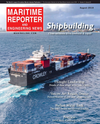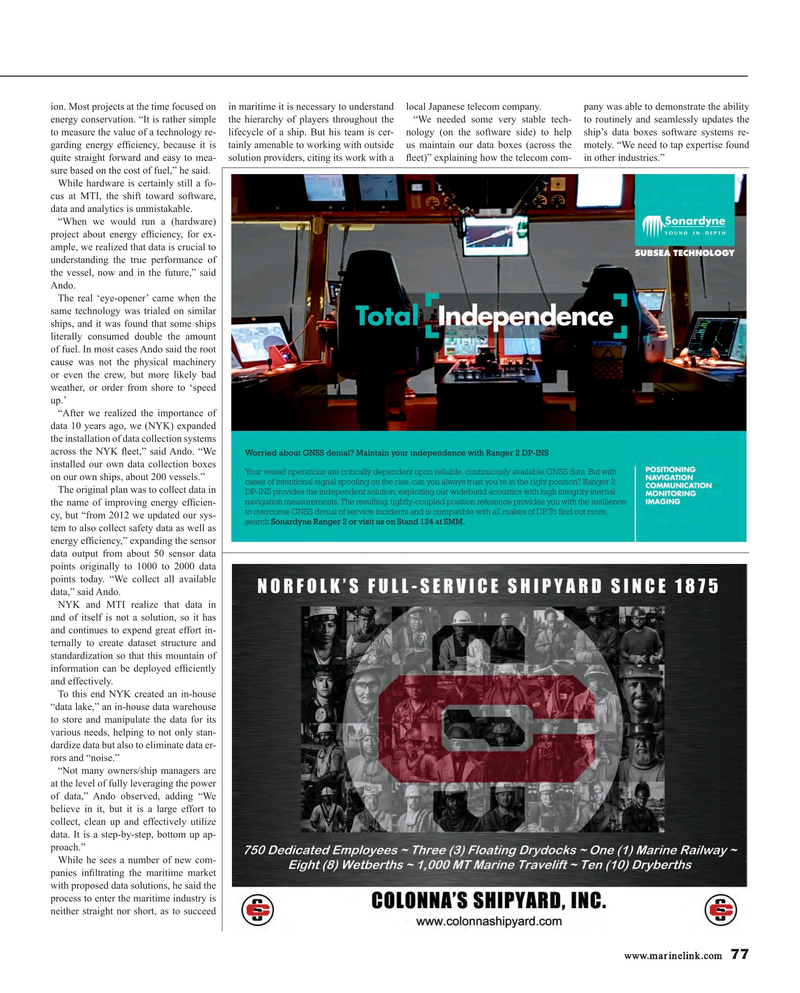
Page 77: of Maritime Reporter Magazine (August 2018)
The Shipyard Edition
Read this page in Pdf, Flash or Html5 edition of August 2018 Maritime Reporter Magazine
ion. Most projects at the time focused on in maritime it is necessary to understand local Japanese telecom company. pany was able to demonstrate the ability energy conservation. “It is rather simple the hierarchy of players throughout the “We needed some very stable tech- to routinely and seamlessly updates the to measure the value of a technology re- lifecycle of a ship. But his team is cer- nology (on the software side) to help ship’s data boxes software systems re- garding energy ef? ciency, because it is tainly amenable to working with outside us maintain our data boxes (across the motely. “We need to tap expertise found quite straight forward and easy to mea- solution providers, citing its work with a ? eet)” explaining how the telecom com- in other industries.” sure based on the cost of fuel,” he said.
While hardware is certainly still a fo- cus at MTI, the shift toward software, data and analytics is unmistakable.
“When we would run a (hardware) project about energy ef? ciency, for ex- ample, we realized that data is crucial to understanding the true performance of the vessel, now and in the future,” said
Ando.
The real ‘eye-opener’ came when the same technology was trialed on similar ships, and it was found that some ships literally consumed double the amount of fuel. In most cases Ando said the root cause was not the physical machinery or even the crew, but more likely bad weather, or order from shore to ‘speed up.’ “After we realized the importance of data 10 years ago, we (NYK) expanded the installation of data collection systems across the NYK ? eet,” said Ando. “We installed our own data collection boxes on our own ships, about 200 vessels.”
The original plan was to collect data in the name of improving energy ef? cien- cy, but “from 2012 we updated our sys- tem to also collect safety data as well as energy ef? ciency,” expanding the sensor data output from about 50 sensor data points originally to 1000 to 2000 data points today. “We collect all available data,” said Ando.
NYK and MTI realize that data in and of itself is not a solution, so it has and continues to expend great effort in- ternally to create dataset structure and standardization so that this mountain of information can be deployed ef? ciently and effectively.
To this end NYK created an in-house “data lake,” an in-house data warehouse to store and manipulate the data for its various needs, helping to not only stan- dardize data but also to eliminate data er- rors and “noise.” “Not many owners/ship managers are at the level of fully leveraging the power of data,” Ando observed, adding “We believe in it, but it is a large effort to collect, clean up and effectively utilize data. It is a step-by-step, bottom up ap- proach.”
While he sees a number of new com- panies in? ltrating the maritime market with proposed data solutions, he said the process to enter the maritime industry is neither straight nor short, as to succeed www.marinelink.com 77
MR #8 (74-81).indd 77 MR #8 (74-81).indd 77 8/6/2018 12:36:38 PM8/6/2018 12:36:38 PM

 76
76

 78
78
